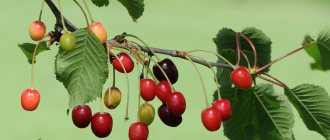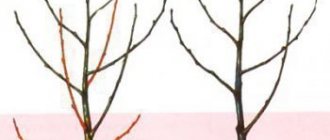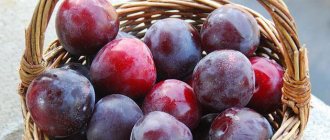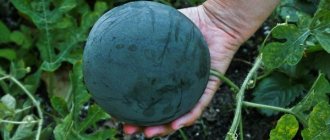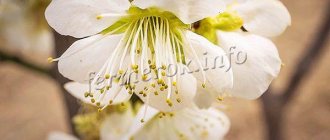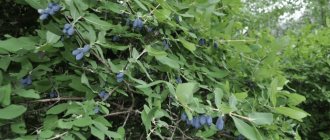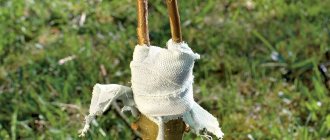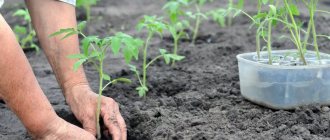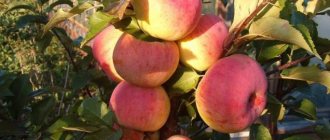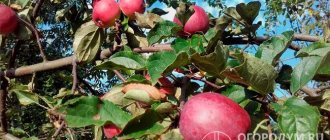Cherry variety Fatezh: description and characteristics, planting and care, reviews from those who grow
Gardeners from different Russian regions would like to grow cherries in their gardens. However, the varieties of this stone fruit tree are distinguished by their increased heat-loving nature and low resistance to frost, so it is impossible to grow this crop in Siberia, the Urals, or in the middle zone - their shoots and flower buds freeze out, as a result, the yield of such varieties of cherries is almost zero.
However, over the past decades, breeders from around the world have been developing new varieties of fruit trees with improved characteristics, including increased resistance to frost and changes in weather conditions, good yield, resistance to attack by pests and many diseases.
One of the best varieties of cherries bred by Russian breeders for cultivation in regions with harsh winters is Fatezh.
The main characteristics, advantages, nuances of planting and further care of this fruit tree will be discussed below.
The content of the article:
1. History of creation 2. Characteristics and description of the variety 3. Productivity of the Fatezh cherry variety 4. Pollinator trees for Fatezh cherries 5. Diseases and pests 6. Advantages and disadvantages 7. Dates for planting cherries 8. How to choose the right planting site 9. What you can plant next to cherries 10. Planting Fatezh cherries 11. Further care 11.1 Fertilizing 11.2 Pruning cherries 12. Reviews of Fatezh cherries
Care
Caring for cherries consists of:
- watering This is especially important for young trees. Mature trees are watered as needed. If there is enough natural precipitation, then the cherries do not need to be watered;
- weeding, which is done periodically to clear the soil of weeds. It is also necessary to remove organic debris, in which harmful bacteria, fungal spores and insect larvae can multiply;
- loosening the soil for better oxygen supply to the root system;
- feeding If sufficient fertilizer was applied during planting, the trees can be fed only starting from the third year of growth. Fertilizers are applied twice per season. In the spring, fertilizing is done with nitrogen fertilizers, and in the fall with phosphorus and potassium fertilizers. Do not forget about organic matter, which is also necessary for good growth and fruiting;
- pruning carried out in the spring to form the crown. The shoots are shortened by 1/3 of the entire length;
- shelter for the winter. Young trees must be covered before wintering. Adults are covered only if the winter is expected to be frosty and with little snow.
History of the variety's creation
This cherry variety is the fruit of the work of Russian breeders A. I. Evstratov and K. K. Enikeev from the All-Russian Breeding and Technological Institute of Horticulture and Nursery Growing. Work on developing a new variety was carried out at the end of the last century. Leningradskaya yellow cherry was taken as the parent variety; during the work, the breeders used biostimulants, as well as gamma rays.
At the end of the last century, a new variety was developed and named Fatezh.
For a couple of years, new cherries were tested, and as a result, in 2001, this variety was included in the Russian State Register and recommended for cultivation in the Central and North-Western regions.
Cherry Fatezh - photo
general information
“Fatezh” is a mid-early variety obtained by hybridizing the original “Leningrad yellow” cherry plant. Forms a medium-height tree with a round and uniform crown. Suitable for growing in the Moscow region and Central Russia. Officially registered in 2001, since then it has gained great popularity and success.
In the photo - Fatezh cherry:
Cherry Fatezh
Main characteristics of the variety:
- The tree reaches a height of 3 – 5 meters.
- The leaves are smooth and large, with pronounced jagged edges.
- The crown is slightly drooping, the skeletal branches are located at a right angle to the trunk.
- The berries are round in shape, average weight is from 4 to 6 grams. The color is yellow with a pink blush, the flesh is elastic and juicy.
- The fruits tolerate transportation and storage well.
- The seed is small and easily separated from the pulp.
- Productivity is high, can reach 50 kilograms per tree.
- Ripening period: end of June – beginning of July.
- It has a high degree of frost resistance and is not susceptible to most common diseases.
- The variety is self-sterile and requires pollinators.
But what varieties of columnar cherries exist for the Moscow region, what they look like. and what they are called, this video will help you understand.
Video review of the Fatezh variety:
According to the tasting assessment, the fruits deserved almost the maximum - 4.7 points out of five possible. Dessert berries, universal purpose. One of the main advantages is long-term storage, which will allow it to be used for commercial purposes.
Sweet cherry Fatezh: characteristics and description of the variety
The Fatezh cherry variety is quite tall - at least 3 m in height, but some trees can grow up to 5 m.
The crown of the tree is voluminous, rather spreading, its shape is round, as the lower shoots slope towards the soil. The bark of the central trunk and shoots is smooth and brown. The shoots are located at an angle to the central trunk, well leafy. The foliage is wide and elongated, with small denticles at the edges. The upper leaf plates are smooth, with a characteristic shine, bright emerald color. On the reverse side, the leaves are lighter, with clearly visible veins.
The resistance of the Fatezh cherry variety to frost is quite high - it can easily tolerate cold temperatures down to -25-28 degrees Celsius.
But the flower buds of the Fatezh cherry often suffer from recurrent spring frosts, but with good care this fruit tree recovers quite quickly and after a couple of seasons begins to bear fruit again as abundantly as before.
Also, this Fatezh cherry is characterized by increased resistance even to long periods of drought, as it loves well-drained types of soil.
Important!
Stagnation of moisture negatively affects Fatezh cherries, the tree develops worse, and various types of rot can occur.
This tree blooms for the first time 4 years after planting the seedling in a permanent place; the buds bloom simultaneously with the appearance of leaves. Flowers form on young shoots - on the lower buds, as well as on bouquet branches.
Photo of Fatezh cherry
Ripe berries of the Fatezh variety are round in shape, slightly flattened, the color is red with a yellowish tint. The weight of the fruit is up to 5 g. The skin is smooth and quite dense, but when eaten it is practically not felt. The pulp is very tasty and juicy, the taste of Fatezh cherries is dessert.
On a note!
Experts' assessment of the taste qualities of ripe Fatezh cherry fruits is 4.8 points, which is a very high indicator.
During heat treatment, the berries do not burst or become deformed, so they can be used not only for fresh eating, but also for canning. Fatezh cherry berries are also used in cooking - for preparing desserts and decorating culinary products.
Ripe berries are not prone to cracking due to their thick skin and tolerate long-distance transportation well. The harvested crop can be stored in the refrigerator for quite a long time.
Characteristics of cherries
Also check out these articles
- Stavropol breed of sheep
- Application of remotely controlled pipeline fittings in agriculture
- Tomato variety Batyanya
- Compote of plums and apples
The characteristics of the variety are presented below.
- Cherry Fatezh needs pollination. Without this, a large harvest cannot be expected on the tree. Pollinators for it are selected such that they have the same flowering period. This could be Chermashnaya, Raditsa, Ovstuzhenka, Crimean, Iput cherries.
- The first fruiting is observed 5-6 years after planting.
- Berries can be transported over long distances without loss of taste or marketability.
- The berries are beautiful, aromatic, tasty, suitable for mass marketing.
- Trees are resistant to short-term droughts.
The leaves are dark green, large, elongated, pointed towards the tip, lanceolate in shape.
- High yield. In the first couple of years after the start of fruiting, the crop produces 4-5 kg of cherries per tree. From an adult tree, if there are pollinators on the site, 30-50 kg of crop is harvested per season.
- Frost resistance is high. The tree does not need shelter when grown in the southern regions, but in the central regions it still needs to be insulated.
Interesting!
Thanks to its low tree size, Fatezh cherries are easy to treat against pests, diseases and harvest.
Diseases and pests
Fatezh cherry has high immunity, so it is practically not affected by fungal diseases, including moniliosis and coccomycosis. Of all the diseases, gum disease poses the greatest danger to this stone fruit tree. But this disease can be avoided if you follow the rules of planting and further care.
Among the pests, this cherry tree is affected by the following insects:
- cherry fly;
- aphid;
- moth.
Pros and cons of the variety
The advantages of the domestic hybrid are obvious:
- frost resistance;
- drought resistance;
- immunity to diseases;
- high productivity;
- good transportability of berries due to their dense texture;
- excellent taste;
- small size of the tree, which facilitates the harvesting process.
As for the shortcomings, the Fatezh cherry has only two. This is the need for planting nearby pollinators and the lack of resistance to gum disease. Otherwise, the variety has no competitors, especially among the climate of the central zone.
Advantages and disadvantages
The main advantages of the Fatezh cherry variety include:
- the trees are not too tall, the shoots are located correctly, so harvesting from this cherry is easy;
- high frost resistance of Fatezh cherries;
- the fruits have an excellent presentation and good taste, tolerate long-distance transportation well and can be stored for a long time in appropriate conditions;
- Fatezh cherries are highly resistant to fungal diseases.
Among the disadvantages of the variety are noted:
- the self-sterility of the Fatezh cherry, which is why it is necessary to plant pollinating trees nearby;
- high probability of gum formation;
- This variety is grown in a fairly narrow area.
Cherry varieties!
Cherry Leningradskaya black Cherry Ovstuzhenka
Dates for planting Fatezh cherries
When growing this variety in the Central and Northwestern regions, young Fatezh cherry trees are planted only in the spring. So that the plants have time to acclimatize and get stronger before the onset of a cold, harsh winter.
But in warmer regions, Fatezh cherries can be planted in the fall - a month and a half before the onset of cold weather. During this period, the trees have time to take root normally and easily tolerate mild, warm winters.
Planting cherries in spring - video
It should be remembered that seedlings with an open root system take root well only when planted in spring, and acquired trees with closed roots take root well in the spring and autumn.
The optimal time for planting Fatezh cherry seedlings is from the last days of April to the first days of May (before the buds of the trees begin to swell).
Rules for further care
In the first two years after planting, the plant does not need fertilizing; what is added before planting is quite sufficient. Further care has its own characteristics, which you must learn about in order to successfully grow cherries of this variety.
Important activities during cultivation:
- Abundant watering is necessary for a young plant . As the branches and crown grow, it is reduced.
- Loosening of the soil is carried out regularly, but shallowly, so as not to damage the rhizomes.
- In the third year after planting, you can feed the plant . Nitrogen fertilizers are used in the spring, and potassium and phosphorus are used after harvesting (for better formation of fruit buds for the next harvest). Feeding is also gradually increased, based on the size and needs of the cherry.
- Pruning is carried out in the spring to remove old and frozen branches. Formative pruning is carried out at the end of the season. To do this, each shoot is shortened by no more than a third of the length that has grown during the season. The cut areas must be treated with garden varnish to prevent infection.
- Disease prevention is also carried out in the spring . For this purpose, broad-spectrum drugs are used. Despite the variety's resistance to diseases, unfavorable conditions can cause shoots to be damaged by fungus or attack by pests.
- The variety is quite frost-resistant, so it does not require winter shelter. For young seedlings, they are used as needed, an adult plant - only in case of a cold and snowless winter.
But this description will help you understand how to care for Black Prince cherries.
On the video - how to care for a cherry seedling:
Cultivation activities are not difficult. The harvest is carried out as it ripens. It is advisable to separate the berries along with the cuttings for longer storage. After harvesting the fruits, you can feed the tree with phosphorus-potassium fertilizers.
It will also be interesting to learn about the description of the Ovstuzhenka cherry variety.
But what the cherry variety Bull's Heart looks like, and what are the features of its cultivation, is indicated here.
It is worth learning more about the height of the Bryansk pink cherry tree: //gidfermer.com/sadovodstvo/yagody/chereshnya-bryanskaya-rozovaya-opisanie-sorta.html
Maybe
How to choose the right landing site
It is very important to choose the right place to plant this variety.
The area for planting Fatezh cherries must meet the following requirements:
- the soil is loose, fertile, without stagnant moisture;
- the groundwater level should not be closer to the ground surface than 2-2.5 m;
- the area is closed from drafts and gusts of cold wind and well lit;
- The landing site should be located on a hill, but not in a lowland or on a northern slope.
The acidity of the soil should be neutral or slightly alkaline. It is better to retreat at least 3 meters from the house or other buildings, so that in the future there will be no problems with the foundation, which can be destroyed by the roots of the cherry tree.
Growing and caring for cherries
To grow a strong and healthy tree, you need to consider several points when planting:
- landing place. Cherries are grown in a sunny and level place, perhaps on a hill. The soil must be fertile. Other shrubs and varieties can grow with the tree, but at a distance of at least 3 meters;
- seedlings. The main method of propagation is seedlings. They must be tall (from 1 meter) and healthy. The stem already has several grown shoots, but the buds have not yet bloomed. The root system of seedlings is already well branched;
Important! Before planting seedlings in the ground, they are soaked in a weak solution of potassium permanganate or in a growth stimulant. Both additives will have a positive effect on the bush’s survival in a new place and ensure its full development.
- Land for cherries. The best soil for growing is considered to be porous, well-permeable soil with a neutral pH. The soil should not be acidified or alkalized. Additionally, 2 weeks before planting, 2 buckets of peat and humus, 500 grams of superphosphate and 100 grams of any potassium additive are added to the soil at the rate of 1 square meter of soil;
- Boarding time. The optimal time for planting is April. The earth is saturated with moisture, and the sun is already beginning to warm. The earth should be no colder than 10 degrees Celsius. You can plant cherries later, but in summer it is not advisable.
Cherries are planted in a hole with a diameter of 1 meter. After planting, insert a support and tie the bush to it. The earth is being spilled. When the tree takes root and begins to grow, a groove is made in the ground around it. The groove should be located at a distance from the trunk and be no more than 5 centimeters deep. When watering, water must be poured into the recess, then it will accurately flow to the roots.
Cherries need to be watered in the morning or evening 1-2 times a month. If the summer is rainy, then they refrain from watering. The tree does not tolerate excess moisture in the soil, so excess watering can have a detrimental effect on the cherry.
Even inexperienced and novice gardeners know about pruning cherries, but they are afraid to do it. In fact, the procedure helps to increase and speed up yields, as well as obtain high-quality berries. Cherry trees are pruned for the first time next spring, in March. When the crown begins to thicken, remove the tier of branches. The tree should grow with lateral branches. The pruning is then repeated in the fall, when the tree is prepared for winter. The leaves should already be shed. First of all, diseased and dried branches are pruned, and after pruning they are burned. Then the largest and oldest shoots are cut off. As a result, the number of branches on the tree should decrease by 1/3.
Attention! All cut areas are treated with garden varnish or cauterized with a weak solution of potassium permanganate. It is allowed to use hydrogen peroxide; it also has an antibacterial effect.
What can be planted next to the Fatezh cherry
In the tree trunks of this cherry tree, it is recommended to grow honey plants that actively attract pollinating insects.
The best neighbors for this stone fruit crop are cherries, apricots, plums or grapes.
It is not recommended to plant near cherries:
- vegetable plants from the nightshade family;
- fruit bushes (raspberries, gooseberries, currants), as they take a large amount of nutrients from the soil;
- sea buckthorn, which prevents the active growth of the roots of neighboring trees and shrubs.
Fruit trees:
Chinese plum Alyonushka Apricot Tsarsky Cherry Zhukovskaya
Planting Fatezh cherries
It is better to purchase seedlings of this variety in nurseries. They should not have visible damage, the height of the above-ground part should not be more than a meter, the length of the roots should be up to 25 cm, 4-5 strong shoots with a thickness of at least 1.5 cm.
Planting holes for Fatezh cherries are prepared in advance, their size is 0.7 * 0.7 * 0.7 m. The distance between neighboring cherries is 3.5 m
.
Planting cherries and initial pruning - video
A layer of drainage 5-6 cm thick is laid at the bottom of the pit, then a layer of nutrient substrate consisting of a kilogram of ash, 100 g of sodium sulfate and 400 g of superphosphate. The next layer is garden soil.
A seedling is placed in the center of the hole, its roots are straightened, and a peg is driven in nearby, to which the cherry is tied. Then the hole is covered with earth.
Important!
The root collar of the cherry is buried 6-7 cm into the soil.
The soil is compacted, at least 3 buckets of water are poured under each tree and a layer of mulch about 5-6 cm thick is poured.
Landing Features
Planting Fatezh cherries is not much different from other varieties. The peculiarities of the planting process are more likely related to climatic conditions, since this variety is zoned for a region in which the cultivation of cherries is generally uncharacteristic.
Recommended timing
In the Central and Northwestern regions, it is best to plan planting Fatezh cherries in the spring, since young and weak seedlings may not tolerate winter frosts after autumn planting.
In southern regions with mild winters, you can plant cherries in October, 15-20 days before the planned onset of frost. During this time, the cherry tree will have time to take root in a new place. The condition of the root system also influences the planting date. A seedling with bare roots can take root only when planted in spring; plants in a container (with a closed root system) successfully take root both in spring and autumn.
The optimal time for planting Fatezh cherries in the spring is April; if spring comes late, then planting can be postponed to the beginning of May.
Choosing a suitable location
The choice of landing site should be taken seriously. Fatezh cherry is demanding both in terms of soil quality and location on the territory. Heavy clay soils with close groundwater, open areas with strong winds and drafts, northern slopes and shaded areas, as well as lowlands are absolutely not suitable.
Areas fenced from the wind are well suited for planting cherries: old gardens, southern forest edges and slopes. It is allowed to plant Fatezh cherries along the walls of the house, but you need to retreat at least 3 m to avoid problems with the foundation in the future.
It is also worth considering that cherries need a well-lit area and light, well-drained loamy soil. Soil acidity should be neutral within 6-7 pH. Groundwater occurrence is at least 2 m deep. Otherwise, you need to either form a high bed or artificially create a high-quality drainage layer.
What crops can and cannot be planted next to cherries?
Proper proximity helps plants develop more actively and protects them from diseases and pests. Since Fatezh cherries do not self-pollinate, it is recommended to sow honey-bearing herbs nearby. They actively attract bees and prevent the growth of weeds. Recommended honey plants:
- clover;
- mustard;
- phacelia.
For active growth of Fatezh cherries, any trees and shrubs with stone fruits are suitable:
- cherry;
- apricot;
- plum;
- grape.
The following crops are not suitable for growing together:
- Nightshades (tomatoes, potatoes, peppers) – spread diseases.
- Gooseberries, raspberries, currants take away nutrients.
- Sea buckthorn – blocks the development of the root system.
Selection and preparation of planting material
High-quality seedlings can only be purchased from a trusted nursery. The optimal height of the seedling is no more than 1 m, the root system is no more than 0.25 m. The cherry tree should have 5 healthy branches about 2 cm thick.
Before purchasing, you need to carefully inspect all parts of the plant. There should be no creases or other damage to the branches and roots. Black roots indicate the presence of a disease. Leaves need to be examined from all sides, since pests and diseases are often found on the underside of the leaf blade.
Advice! You should not choose a seedling that is too tall, it will take root worse. There should be a slight curvature at the bottom of the trunk (5-15 cm from the ground), this indicates the presence of a graft.
Landing algorithm
Planting holes must be prepared in the fall, regardless of planting time. The hole should be 0.7 m x 0.7 m x 0.7 m in size. For mass planting, the distance between the holes is 3 m.
The bottom of the hole is laid with a layer of drainage up to 7 cm thick. Expanded clay or broken brick are suitable as drainage. The next layer is a nutrient mixture of 1 kg of ash, 0.1 kg of sodium sulfate, 0.4 kg of superphosphate. Next comes a layer of earth 10 cm thick.
The seedling is placed on this layer, the roots are carefully straightened. You need to stick a peg next to the seedling and tie the plant up. The planting hole is covered with earth so that the root collar of the cherry tree is buried 5-8 cm. The earth is compacted and watered generously with 30 liters of water. Lay a mulching layer of peat or humus 3-5 cm thick on top.
Sweet cherry Fatezh: reviews from those who grow the variety
Evgeniya, 40 years old, Moscow region: Fatezh cherry has been growing in my garden for 7 seasons. The seedlings took root well and did not freeze even in cold winters. The first fruits were collected 5 years after planting. This season the yield was quite high - almost two buckets of ripe berries were harvested. I use them to make very tasty compotes. We plan to plant several more trees of this variety.
Tamara, 50 years old, Tushino: Fatezh planted cherries 3 years ago. I take care of it according to all the rules, making sure to cover it for the winter so that the branches do not freeze. I planted Bryansk cherries nearby so that they would mutually pollinate. I'm looking forward to the first harvest. If I like the fruits, I will definitely plant a couple more trees of this variety.
Alexandra, 55 years old, Ryazan: A couple of Fatezh cherry trees grow in my garden. They are already 9 years old, they are already actively bearing fruit, and have not yet frozen out in winter. During the season, I didn’t even notice that they were damaged by pests. The berries are tasty and sweet. My family really likes compotes made from this cherry.
Fatezh cherries are successfully grown by gardeners in many regions of the Central region, as well as in the North-West of Russia.
Fatezh cherries are highly valued due to the following qualities: high resistance to frost and disease, good yield, excellent taste of the fruit.
Collection, storage and use of crops
The berries begin to ripen in mid-July. The yield is high (30 kg of berries can be collected from a 10-year-old tree), so the fruit must be collected in stages as it ripens. Fruits should be picked in dry weather, preferably early in the morning. For immediate processing, you can collect berries without petioles - they are cut dry, so they will not “leak”. For storage or transportation, cherries must be picked with the petioles and placed in a dry container so that the petioles do not damage neighboring berries.
At least 10 varieties of jam are made from cherries
You can store the harvest in the refrigerator, but cherries do not sit for more than 5–7 days. Therefore, if possible, you need to eat fresh cherries, and from what you can’t eat, make compotes, jam or dried fruits.

